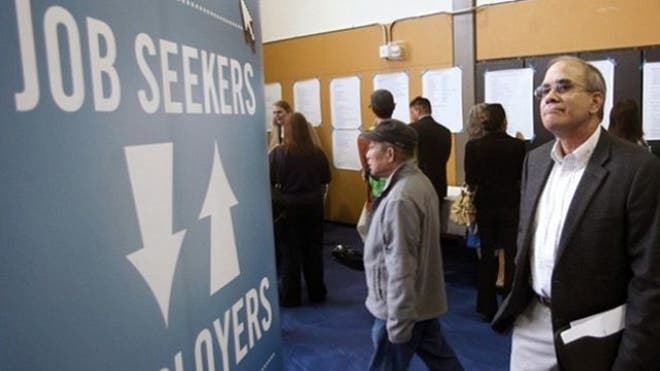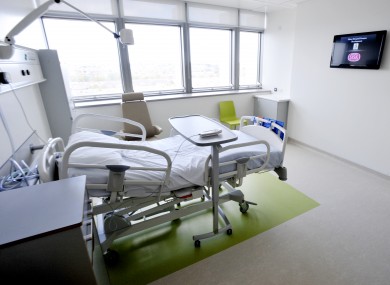Irish Jobs growth rate speeds up as employment rises by 3.2% in third quarter
Unemployment in Irelnd fell by 12.8% or 41,700 in the year since the third quarter of last year
Minister for Social Protection Joan Burton said there were still far too many people out of work, and that tackling unemployment remained the Government’s number one priority, but said the figures demonstrated steady progress.
The rate of employment growth accelerated during the third quarter of 2013, according to the latest figures from the Central Statistics Office.
There was a year-on-year increase in employment of 3.2 per cent, or 58,000, for the third quarter of this year as compared with the same quarter last year, according to the Quarterly National Household Survey results. Total employment rose to 1,899,300.
The 3.2 per cent year-on-year rise compares with an increase of 1.8 per cent for the previous quarter, 1.1 per cent for the first quarter and 0.1 per cent for the last quarter of 2012. A comparable rate of increase in employment was last seen at the end of 2007, Brian Ring of the CSO told a media briefing yesterday.
The household survey figures are the official or definitive labour force estimates for the Irish economy.
Unemployment fell by 12.8 per cent, or 41,700 in the year since the third quarter of 2012, reducing the total number of people out of work to 282,900.
The comparable percentage fall for the second quarter was 6.9 per cent. The preceding quarter recorded an even higher year-on-year rate of decline, of 9.3 per cent, but the two quarters prior to that recorded falls of 6.1 per cent and 1.1 per cent, making for a general trend towards accelerating fall-off in unemployment.
Long-term jobless: The numbers in long-term unemployment fell at a faster rate than did the numbers of unemployed overall, while the rise in full-time employment was greater than the rise in part-time employment.
Minister for Social Protection Joan Burton said there were still far too many people out of work, and that tackling unemployment remained the Government’s number one priority, but said the figures demonstrated steady progress.
“Especially important is the fact that the majority of people returning to work are returning to full-time employment,” she said.
David McNamara of Davy said the data provides further hard evidence the Irish economy bounced back in the second half of this year. He said he expected the strong rise in employment to drive consumer spending in the second half of this year and into 2014, causing Davy to leave its above-consensus forecasts for gross domestic product growth unchanged at 1 per cent in 2013 and 2.5 per cent in 2014.
If anything, our current unemployment forecasts of 13.7 per cent in 2013 and 12.8 per cent in 2014 now look too pessimistic, so we would expect to revise down those estimates.
SME criticism: Similar positive responses were issued by other observers, though Isme chief executive Mark Fielding said the increase is “needlessly slow” and if the Government would only listen to the owners of small and medium-sized enterprises, more jobs would be created.
HSE has lesson’s to learn from case of Marie Fleming medical card,
 says Taoiseach Kenny
says Taoiseach Kenny
KENNY SAYS MINISTER FOR HEALTH HAS THREE WEEKS TO CONSIDER PLAN FOR HEALTH SERVICES
Sinn Fein Leader Gerry Adams said Ireland was “the worst small country in the western world in which to be sick.”
Taoiseach Enda Kenny has said he accepts the Health Service Executive (HSE) has a lesson to learn following the difficulty terminally-ill multiple sclerosis sufferer Marie Fleming had in retaining her medical card.
He said there should be a simple and effective way of dealing with a person who was terminally ill. “There is a lesson to be learned in there by the HSE in the sense that there is a terminally ill person . . . and that is, unfortunately, not going to change,” he added.
“Therefore, there has to be an effective and compassionate and understanding process of the continuation of the card.”
Mr Kenny said it was something “that, unfortunately, in this case, points out where a change must occur in the process of renewal so that people do not have to deal with the verification of an illness that is terminal”.
He added that while he did not have the details of the case, his understanding was that the medical card was issued, not on a discretionary basis, but on entitlement on income and medical grounds.
“So it is a case of the renewal of an ordinary medical card,” he added. Mr Kenny said a person did not become “unterminally ill”.
‘Outrageous and inhuman’
The Taoiseach was replying to Fianna Fáil leader Micheál Martin, who said Ms Fleming’s case was known to the House and the entire country.
“Her condition is well known: she is terminally ill,” he added. “Yet she did not get her medical card automatically renewed.”
Independent TD John Halligan said what happened was “outrageous and inhuman’’, adding that the Taoiseach knew the details of the case.
Mr Kenny said that if he had listened correctly to Marie’s partner, he was saying he was not objecting to the renewal process. The fact was that it appeared as if there was contact on a number of occasions from the HSE about the verification of her medical condition.
Mr Halligan said the HSE knew the facts. “That is outrageous,’’ he added. “She is critically ill.”
Mr Kenny said that once it was verified that a person had a terminal illness, whatever that illness was, there should be an understanding how to put in place an effective renewal process which took pressure off the person.
Sinn Féin leader Gerry Adams said the 2014 national service plan delivered by the HSE to Minister for HealthJames Reilly included almost €700 million in cuts and there was speculation that the figure could be closer to €1 billion.
Mr Adams said Ireland was “the worst small country in the western world in which to be sick.”
“We were told at the weekend that patients with breast, bowel and cervical cancer fared worse here than in the vast majority of industrialised states from 2006 to 2011,” he added.
He said that last Friday the HSE had confirmed that 24 health agencies, including some hospitals, were paying top-ups to their managers.
“In a republic, or indeed in any decent society, citizens have a right to a first-class health service on the basis of need,” he added.
Three weeks: Mr Kenny said the Minister now had three weeks to reflect upon and consider the plan and comment on it.
“That work is already under way, so I do not want to comment any further on it except to confirm that it has been delivered,” he added.
Pressed further by Mr Adams, the Taoiseach said the Departments of the Taoiseach, Public Expenditure and Health were currently examining the plan.
Over 40,000 people in Ireland have a dangerous heart rhythm disorder
AND THEY DON’T EVEN KNOW ABOUT IT.
Only 2 per cent of us believe Atrial Fibrillation is a serious condition, yet it’s responsible for about 30 per cent of strokes.
Did you ever hear of Atrial Fibrillation? Well, you’re in good company. Three-quarters of us haven’t, according to the Irish Heart Foundation.
The condition is the most common form of heart rhythm disorder, according to the IHF, and the charity’s secured the services of former Munster and Ireland rugby stalwart Frankie Sheahan to help educate the public on the risks associated with it.
The disorder usually has no symptoms, so most people don’t know they have it. However, warning signs can include palpitations, tiredness and shortness of breath. It’s more common as people get older, and it’s estimated more than 40,000 people over 50 years old in Ireland suffer from it; most are unaware.
Diagnosed at the age of 30, Sheahan’s sporting career was thriving until he started having difficulty breathing and feeling like his heart was fluttering.
“I could feel my heart pounding and it was hard to get my breath but my immediate thought was, it will pass so get on with it,” the former hooker said.
“I didn’t want anything to interrupt my rugby career so I was very secretive about it despite having a lot of anxiety about it.”
He says the condition got worse over the next few years “as did my performances,” and after he sustained a serious neck injury at around the same time, Sheahan decided something had to change.
“Dr Gerry Fahy subsequently did a very successful ablation procedure and in hindsight, I wish I’d spoken out about my heart sooner because after the operation, I was better than ever before.”
The IHF launched a new radio awareness campaign yesterday to stress the importance of regular pulse checks to detect the condition, which causes around one in three strokes in Ireland.
The charity’s IHF is also providing a step-by-step guide for adults on how to take their own pulse on its website.
According to IHF Medical Director Dr Angie Brown “The recommended normal heart rate is between 60 and 100 heartbeats per minute but some people can have heart rates over 100″.
“You should see your doctor if you have a persistent heart rate above 120 beats per minute or below 40 beats per minute.”
New bankruptcy regime in Ireland within the week
Current bankrupts will be discharged next summer under new bankruptcy rules
The new legislation will mean bankrupts can be automatically discharged from bankruptcy in three years, down from 12 years at present
Changes in bankruptcy legislation that will reduce the length of time a person remains in bankruptcy are to be introduced within the next seven days.
Minister for Justice Alan Shatter, currently in Lebanon, is expected to sign the commencement order for section 4 of the Personal Insolvency Act 2012 dealing with bankruptcy on his return.
Three years
The new legislation will mean bankrupts can be automatically discharged from bankruptcy in three years, down from 12 years at present, although it does include a clause to require the bankrupt to pay a contribution from their income for five years in certain circumstances.
The new legislation will mean bankrupts can be automatically discharged from bankruptcy in three years, down from 12 years at present, although it does include a clause to require the bankrupt to pay a contribution from their income for five years in certain circumstances.
It will also increase the level of debt required to make a person bankrupt. A debtor must owe a creditor €20,000 under the new system before he or she can be forced into bankruptcy or make a petition to declare themselves bankrupt, compared with €1,900 currently.
When a High Court action for bankruptcy is being brought by an individual on their own behalf, the new legislation also requires they make a sworn statement, namely an affidavit.
Among other things, the affidavit must state that before the application for bankruptcy was made, the debtor made efforts to reach an agreement with their creditors using a personal-insolvency or debt-settlement arrangement, new schemes for dealing with insolvency available under the Personal Insolvency Act 2012.
There will also be changes to the value of assets exempted from being seized by the official assignee, a court-appointed trustee who controls the assets and deals with the creditors of a bankrupt. Household furniture or tools and equipment required for the bankrupt’s occupation up to the value of €6,000 will be exempt, a doubling of the current threshold.
Most pensions will also be exempt from being taken over by the official assignee, although if a debtor is due to receive an income from a pension for up to five years after being adjudicated a bankrupt, then that income will be taken over and distributed to creditors.
“Excessive contributions”
If a person made “excessive pension contributions” for up to three years before they became a bankrupt, the court can order the excess be paid to the official assignee and distributed to creditors.
If a person made “excessive pension contributions” for up to three years before they became a bankrupt, the court can order the excess be paid to the official assignee and distributed to creditors.
The new legislation will also affect people who have already been declared bankrupt. Once it is under way, anyone who was declared bankrupt three years ago or more will be automatically discharged from bankruptcy next summer.
Beautiful tiny seahorses stalk their prey by stealth


The Seahorses may appear slow and awkward but they are ferocious and ingenious predators, according to a new study.
The beautiful creatures are famously bad swimmers, but they have a secret weapon to sneak up on their prey.
Their peculiar snouts are shaped to create very few ripples in the water, effectively cloaking them as they creep up and pounce on tiny crustaceans.
People don’t often think of seahorses as amazing predators, but they really are”
To their victims, seahorses are more like sea monsters, say scientists from the University of Texas at Austin.
“The seahorse is one the slowest swimming fish we know of, but it’s able to capture prey that swim at incredible speeds,” said Brad Gemmell, author of the study in Nature Communications. The dwarf seahorse may look delicate, but its snout is a lethal weapon
The prey, in this case, are copepods – extremely small crustaceans that are a favoured meal of seahorses, pipefish and sea dragons (Syngnathidae).
When copepods detect waves from predators, they jolt away at speeds of more than 500 body lengths per second – the equivalent of a 6-foot human swimming at 2,000 mph.
Deadly strike
“Seahorses can overcome one of the most talented escape artists in the aquatic world,” said Dr Gemmell.
“In calm conditions, they catch their intended prey 90% of the time. That’s extremely high, and we wanted to know why.”
Seahorses dine by a method known as pivot feeding. Their arched necks act as a spring – allowing them to rapidly rotate their heads and suck their prey in.
But this suction only works at short distances. The effective strike range for seahorses is about 1 millimetre. And a strike happens in less than 1 millisecond.
Until now it was a mystery how such apparently docile creatures managed to get close enough to their prey without being spotted.
To find out, Dr Gemmell and his colleagues studied the dwarf seahorse, Hippocampus zosterae, which is native to the Bahamas and the US.
They filmed the movement of water around the fish in 3D using holography – a technique where a microscope is fitted with a laser and a high-speed digital camera.
They found that the seahorse’s snout is shaped to minimise the disturbance of water in front of its mouth before it strikes.
Above and in front of its nostrils is a “no wake zone” and it angles its head precisely to attack its prey.
Other small fish with blunter heads, such as the three-spine stickleback, have no such advantage, the researchers found.
“It’s like an arms race between predator and prey, and the seahorse has developed a good method for getting close enough so that their striking distance is very short,” said Dr Gemmell.
“People don’t often think of seahorses as amazing predators, but they really are.”








No comments:
Post a Comment